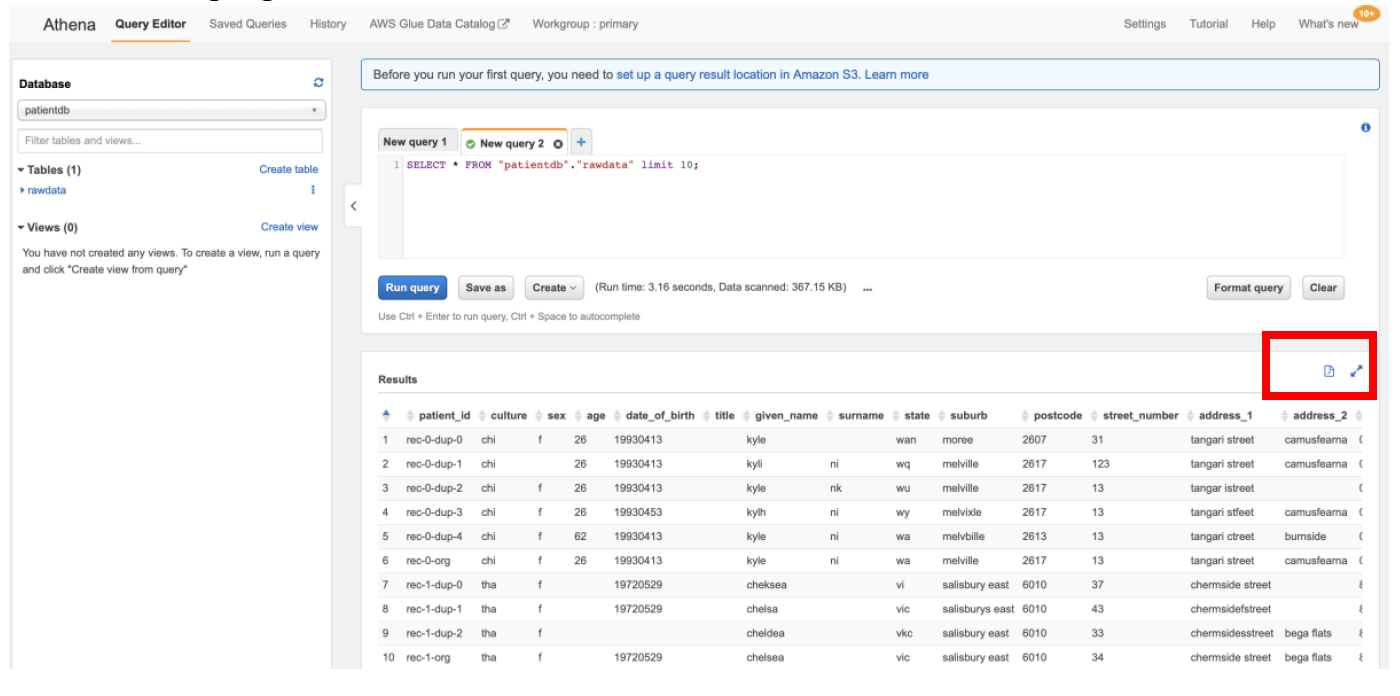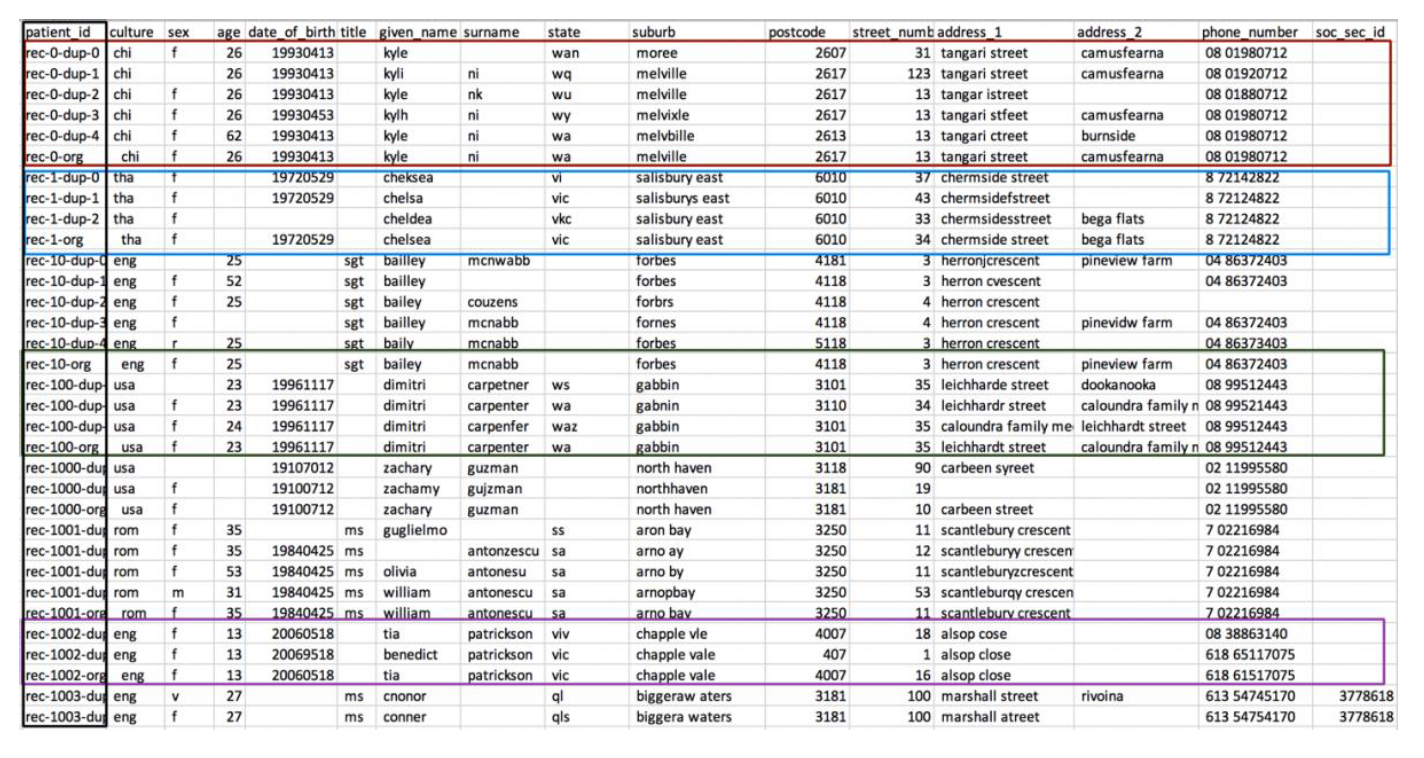[Back to main guide](../README.md) | [Next](activity8.md)
___
## 7. Observe the data pattern and duplicates in data
You can now query data in Data Lake using Amazon Athena. Perform the below steps:
a) Login as **dlanalyst** if not already
b) Navigate to **Lake Formation Console → Data Catalog → Tables**
c) Select the **rawdata** table → **Actions → View data**
d) In the **Athena console** → select database as **patientdb → tables rawdata → options Preview**
e) You can download the csv by removing the **limit** clause in the select statement and clicking on the **Download the results** icon in the Results section
 NOTE:
After landing on Athena console, if you get an error or query doesn’t run, click on the **Set up a query result location in Amazon S3** link and enter the value as **s3://\<\\>/query/**
**Note the trailing slash in the above path!**
NOTE:
After landing on Athena console, if you get an error or query doesn’t run, click on the **Set up a query result location in Amazon S3** link and enter the value as **s3://\<\\>/query/**
**Note the trailing slash in the above path!**

 f) Click on **Save** and run the query. You can download entire dataset by removing the **“limit 10”** clause from the SQL, running the query again and by clicking on the **download** icon as highlighted below.
f) Click on **Save** and run the query. You can download entire dataset by removing the **“limit 10”** clause from the SQL, running the query again and by clicking on the **download** icon as highlighted below.
 g) Open the downloaded file in excel, sort by patient_id and observe the duplicates
g) Open the downloaded file in excel, sort by patient_id and observe the duplicates
 As highlighted with different colors in the above table with identifying different groups that includes the original patient record grouped with its duplicates. The patient_id values are generated in a specific format that helps us identify the such groups. The format is “rec-\-org/dup-\” followed by FEBRL data gen tool.
As a next step, we will create, teach and tune AWS Lake Formation FindMatches ML Transform and then use it in the Glue ETL job to find matches and/or remove the duplicates.
___
[Back to main guide](../README.md) | [Next](activity8.md)
As highlighted with different colors in the above table with identifying different groups that includes the original patient record grouped with its duplicates. The patient_id values are generated in a specific format that helps us identify the such groups. The format is “rec-\-org/dup-\” followed by FEBRL data gen tool.
As a next step, we will create, teach and tune AWS Lake Formation FindMatches ML Transform and then use it in the Glue ETL job to find matches and/or remove the duplicates.
___
[Back to main guide](../README.md) | [Next](activity8.md)

 f) Click on **Save** and run the query. You can download entire dataset by removing the **“limit 10”** clause from the SQL, running the query again and by clicking on the **download** icon as highlighted below.
f) Click on **Save** and run the query. You can download entire dataset by removing the **“limit 10”** clause from the SQL, running the query again and by clicking on the **download** icon as highlighted below.
 g) Open the downloaded file in excel, sort by patient_id and observe the duplicates
g) Open the downloaded file in excel, sort by patient_id and observe the duplicates
 As highlighted with different colors in the above table with identifying different groups that includes the original patient record grouped with its duplicates. The patient_id values are generated in a specific format that helps us identify the such groups. The format is “rec-\
As highlighted with different colors in the above table with identifying different groups that includes the original patient record grouped with its duplicates. The patient_id values are generated in a specific format that helps us identify the such groups. The format is “rec-\ NOTE:
After landing on Athena console, if you get an error or query doesn’t run, click on the **Set up a query result location in Amazon S3** link and enter the value as **s3://\<\
NOTE:
After landing on Athena console, if you get an error or query doesn’t run, click on the **Set up a query result location in Amazon S3** link and enter the value as **s3://\<\